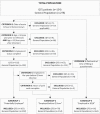Impact of Q-fever fatigue syndrome on patients' work status
- PMID: 33073289
- PMCID: PMC7732754
- DOI: 10.1093/occmed/kqaa166
Impact of Q-fever fatigue syndrome on patients' work status
Abstract
Background: Chronic illnesses can increase the risk of unemployment, but evidence on the specific impact of Q-fever fatigue syndrome (QFS) on work is lacking.
Aims: The aim of this study was to describe and quantify the impact of QFS on work.
Methods: Changes in work status from 1 year prior to 4 years after acute Q-fever infection of QFS patients were retrospectively collected with a self-report questionnaire measuring employment status and hours of paid work per week. In addition, information on work ability, job satisfaction and need for recovery after work was collected in 2016. Data were compared to participants from the general population.
Results: The proportion of employed QFS patients from 1 year prior to 4 years after acute infection decreased from 78 to 41%, while remaining relatively constant in the general population (82 to 78%). Working QFS patients showed a decrease in mean hours of paid work from 35 to 22 h per week, which is significantly steeper compared to the general population (31-28 h per week) (P < 0.001). QFS patients showed a significantly lower work ability (P < 0.001), lower job satisfaction (P = 0.006) and greater need for recovery (P < 0.001) compared to the general population.
Conclusions: The number of QFS patients with paid work decreased over the years, while patients who continue to work experience lower work ability, job satisfaction and increased need for recovery. Occupational physicians should be aware of the occurrence and severity of the impact of QFS on work, even after many years.
Keywords: Job satisfaction; Q-fever; QFS; Work Ability Index; working hours.
© The Author(s) 2020. Published by Oxford University Press on behalf of the Society of Occupational Medicine.
Figures



References
-
- Keijmel SP, Morroy G, Delsing CE, Bleijenberg G, Bleeker-Rovers CP, Timen A. [Persistent fatigue following Q fever]. Ned Tijdschr Geneeskd 2012;156:A5258. - PubMed
-
- Roest HI, Tilburg JJ, van der Hoek W et al. The Q fever epidemic in the Netherlands: history, onset, response and reflection. Epidemiol Infect 2011;139:1–12. - PubMed
-
- Derrick EH. “Q” fever, a new fever entity: clinical features, diagnosis and laboratory investigation. Rev Infect Dis 1983;5:790–800. - PubMed
MeSH terms
LinkOut - more resources
Full Text Sources

